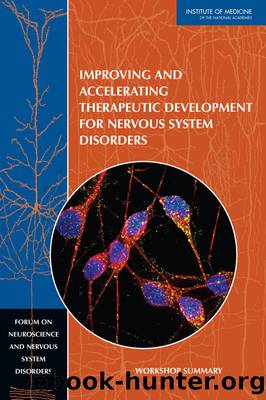Improving and Accelerating Therapeutic Development for Nervous System Disorders: Workshop Summary by Sheena M. Posey Norris

Author:Sheena M. Posey Norris
Language: eng
Format: epub
Publisher: The National Academies Press
Published: 2014-01-23T00:00:00+00:00
⢠embed multiple biomarkers in Phase I/IIa trials in order to develop pharmacodynamic profiles quickly;
⢠develop synaptic and other biomarkers in humans that can give a functional readout in a short timeframe;
⢠test drugs aimed at upstream processes before irreversible downstream damage;
⢠find more potent drugs without dose-limiting toxicity; and
⢠use combination therapies and start them before symptoms appear.
In the case of psychiatric disorders and Diagnostic and Statistical Manual of Mental Disorders (DSM) criteria, John Krystal, Robert L. McNeil, Jr., professor of translational research and chair of the department of psychiatry at Yale University School of Medicine, commented there needs to be a willingness to explore subgroups of patients with mechanistic homogeneity. Connecting genetic networks and quantitative traits might build the case for proof-of-concept studies; the studies would be based on quantitative information rather than behavioral readouts and could be tested in specific patient groups. In summary, Chas Bountra, head of the Structural Genomics Consortium and professor of translational medicine at the University of Oxford, noted that unless biomarkers are discovered, the field faces continued high failure rates in Phase IIa clinical trials. At this stage of drug development, the majority of novel compounds fail (Paul et al., 2010). As a result, target validation, or invalidation, is delayed.
PORTFOLIO ASSESSMENT TOOL FOR TARGET VALIDATION AND QUALIFICATION
Merchant provided her perspective on factors considered when making investment decisions in neuroscience portfolios. Merchant began by noting that attrition in drug development is very high in Phase II studies, with an approximate rate of 66 percent. Major causes of failure in Phase II are related to inadequacies in efficacy, safety, the overall strategic plan, and bioavailability and pharmacokinetic properties (Paul et al., 2010). High attrition underscores the need for better target validation and biomarkers to avoid selection of the wrong target, the wrong patient population, or the wrong dose. Merchant suggested that target validation is best accomplished in humans, while animal models are important for target qualification, which is a step in the process to determine the scientific validity and safety of a target (see Figure 4-1).
Target Validation
There are three major components of target validation using human data: tissue expression, genetics, and clinical experience. For each of these components, several metrics might guide decisions to invest in a particular therapy (see Figure 4-1). Merchant identified specific metrics that might apply in ascending order of priority (see Table 4-1).
Merchant noted that each step toward target validation provides an increasing level of importance on how to interpret data and build confidence in what projects to bring forward. All the componentsâtissue expression, genetics, and clinical experienceâcan inform disease pathways. It is an iterative learning problem. How can what is learned from tissue expression integrate with genetics and integrate with the clinic?
Download
This site does not store any files on its server. We only index and link to content provided by other sites. Please contact the content providers to delete copyright contents if any and email us, we'll remove relevant links or contents immediately.
| Administration & Medicine Economics | Allied Health Professions |
| Basic Sciences | Dentistry |
| History | Medical Informatics |
| Medicine | Nursing |
| Pharmacology | Psychology |
| Research | Veterinary Medicine |
Periodization Training for Sports by Tudor Bompa(7946)
Why We Sleep: Unlocking the Power of Sleep and Dreams by Matthew Walker(6388)
Paper Towns by Green John(4826)
The Immortal Life of Henrietta Lacks by Rebecca Skloot(4274)
The Sports Rules Book by Human Kinetics(4097)
Dynamic Alignment Through Imagery by Eric Franklin(3935)
ACSM's Complete Guide to Fitness & Health by ACSM(3834)
Kaplan MCAT Organic Chemistry Review: Created for MCAT 2015 (Kaplan Test Prep) by Kaplan(3815)
Introduction to Kinesiology by Shirl J. Hoffman(3634)
Livewired by David Eagleman(3547)
The River of Consciousness by Oliver Sacks(3431)
The Death of the Heart by Elizabeth Bowen(3355)
Alchemy and Alchemists by C. J. S. Thompson(3312)
Descartes' Error by Antonio Damasio(3170)
Bad Pharma by Ben Goldacre(3118)
The Gene: An Intimate History by Siddhartha Mukherjee(2942)
The Emperor of All Maladies: A Biography of Cancer by Siddhartha Mukherjee(2942)
The Fate of Rome: Climate, Disease, and the End of an Empire (The Princeton History of the Ancient World) by Kyle Harper(2893)
Kaplan MCAT Behavioral Sciences Review: Created for MCAT 2015 (Kaplan Test Prep) by Kaplan(2832)
